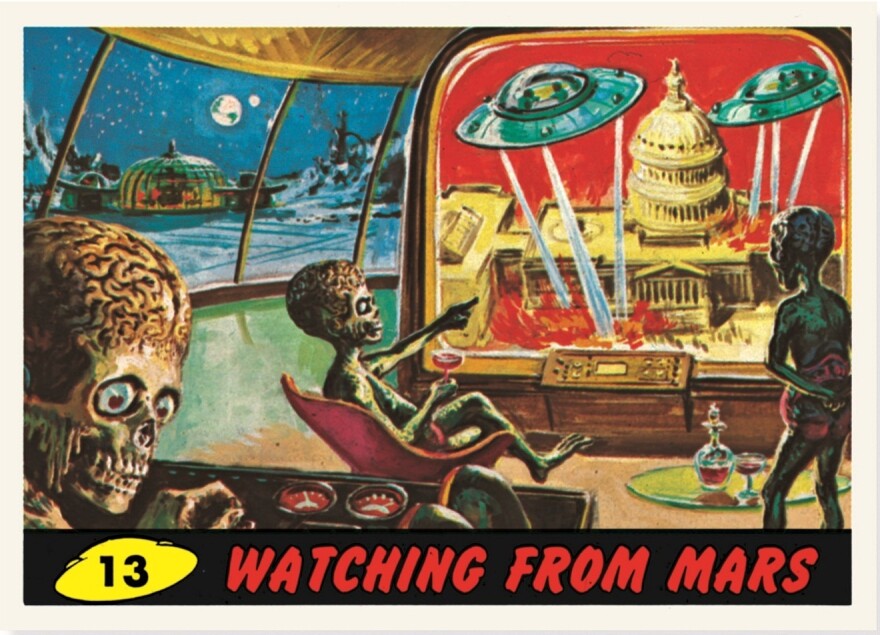Mars Attacks: 50th Anniversary Collection, an anthology of the 1962 trading card series from the Topps Company and Abrams Comic Arts, comes packaged in a jacket made from the same wax paper as '60s bubble gum wrap. The packaging establishes an air of honeyed nostalgia that the cards themselves are mercifully quick to demolish. The 55 violent images of interplanetary slaughter in the "Mars Attacks" series were controversial in their day, but have atrophied in the popular consciousness as kitsch relics of the Kennedy era. The best thing about this 50th anniversary book is that it frees "Mars Attacks" from rose-tinted memory.
Though painted in gorgeous, lurid color by Norman Saunders from drawings by Wally Wood, the "Mars Attacks" series is otherwise proudly inelegant. There is a semblance of a continuing story — about a deadly Martian invasion of Earth, and mankind's successful counterattack — but there are no recurring characters, and only the barest of narrative information. Mars' attack (prompted by "atomic pressures building up beneath the surface of Mars for many years") involves expanding Earth insects to Godzilla-like proportions and slaughtering every human in sight. Earth's brilliant strategy for victory involves (hang on, let me check my notes...) crushing the Martian invaders with tanks and blowing up their planet.

Landmarks like Times Square and the Golden Gate Bridge are predictably flattened, but unlike from the bloodless mayhem of such atom-age entertainments as This Island Earth or Earth vs. the Flying Saucers, "Mars Attacks" revels pornographically in gory carnage. Giant ants chew up "helpless victims"; soldiers and cows are burned alive (in a particularly gruesome touch, we can see the cows' ribcages); civilians are crushed, gunshot wounds spurt blood, and Martin/human rape is implied. The cards have blunt, brutal titles like "Crushed To Death," "Burning Flesh," and "The Human Torch." There is a strain of humor, but is acidic: card #13, "Watching from Mars," shows three Martians enjoying a glass of wine as they observe the destruction of the Capitol on a giant TV.
In an afterward, Norman Saunders' daughter Zina recalls that her father's progressive politics influenced his work. "The civil rights movement: he was for it. Religion: he was against it," she writes. "Dad knew full well that [children] were ferocious little warriors, bloodthirsty and cruel, and delighted by horror. In other words, Dad was the perfect artist for Mars Attacks." Some images seem designed to puncture a certain Leave it to Beaver Americana, like controversial card #36, "Destroying a Dog," in which a Martian blasts through a Labrador retriever as a young boy cries in horror. Even if the series suggests a Cold War anxiety of the loss of the American way of life, the gut-punch power comes from Saunders' secret relishing of the scenario.
The brutality of the images may come as a surprise to anyone whose main exposure to this brand was through Tim Burton's jokey 1996 film adaptation (in which the Martians are defeated by an allergy to Slim Whitman). The second half of the book collects cards from a 1994 revival, plus other "Mars Attacks"-inspired artworks from recent decades, most of which are in the Burton spirit. Zina Saunders draws a Martian holding a panicked President Kennedy at gunpoint; Drew Friedman depicts a civilian being disintegrated in three black-and-white frames of celluloid; Steve Fastner and Rich Larsen show the Martians attending a wet T-shirt contest, etcetera.
These images are generally amusing, but they crumble in the memory compared to the originals. The 1962 cards grab you by the neck, but the revisionists are content to elbow you in the ribs. Too many of the '90s and '00s artists try to be too hip for the material, repositioning it as camp. Many of these artists are old enough to have been scared by "Mars Attacks" as grade-schoolers. It might have been interesting if, instead of condescending to "Mars Attacks," more of them tried to create something to truly scare the next generation.
Copyright 2023 NPR. To see more, visit https://www.npr.org.




